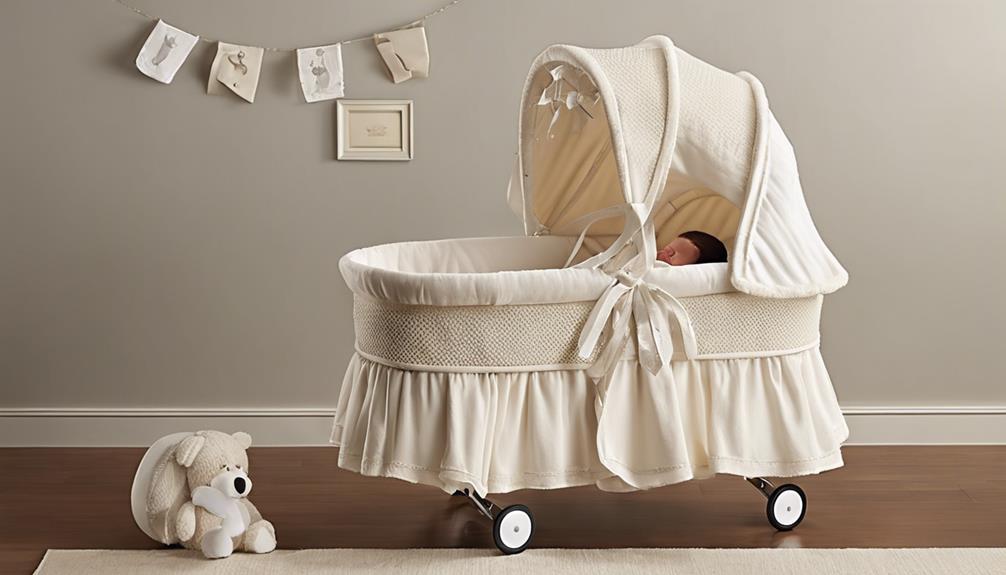When we're exhausted and struggling to put our overtired newborn to sleep, it may feel like an endless battle. However, understanding a few simple strategies can make a world of difference in helping your little one settle down quickly.
From creating a soothing bedtime routine to utilizing gentle techniques like swaddling and rocking, there are effective ways to ease your baby into a restful slumber. But what if there was a secret hack that many parents overlook, a game-changer that could turn those sleepless nights into peaceful ones?
Key Takeaways
- Recognize signs of overtiredness to address quickly.
- Use walking and holding technique for calming.
- Establish healthy sleep habits for newborns.
- Prioritize rest for growth and development.
Signs of Overtiredness in Newborns
What're the clear signs that indicate overtiredness in newborns? Recognizing these signs is important for understanding your baby's needs and ensuring they get the rest they require.
Newborns often display overtiredness through subtle cues like rubbing their eyes, turning away from stimulation, or seeking comfort by sucking their thumb or a dummy. Additionally, autonomic signals such as hiccups, sneezing, and sweaty palms can indicate that your baby is overtired. If your newborn is experiencing unexplained crying, back arching, or pulling their legs up, these may also be signs of overtiredness.
Understanding these signs is essential as grizzly behavior, crying, refusal to feed, and fighting sleep can become more common as babies get older. By promptly recognizing and addressing these indicators of overtiredness, you can help prevent it from escalating and ultimately improve your baby's sleep quality. It's important to pay close attention to your baby's cues and respond accordingly to ensure they get the rest they need.
Techniques to Calm an Overtired Infant

When your infant is overtired, employing specific techniques can effectively calm them and help facilitate better sleep. One technique that has shown success is a combination of walking and holding your baby. Research has indicated that walking for 5 minutes, followed by holding for 8 minutes, can soothe babies and aid in their ability to fall asleep. Nearly 46% of babies in a study fell asleep within 5 minutes using this method. It is crucial to note that the calming effect is not achieved when the baby is held stationary or placed in a stationary bassinet, as observed in a study involving 21 mothers and their babies under seven months old.
| Technique | Effectiveness |
|---|---|
| Walking for 5 minutes, then holding for 8 minutes | Soothes the baby and aids in falling asleep quickly |
| Holding the baby for an additional 8 minutes after walking | Helps the baby fall into deeper sleep and avoid quick awakenings |
Understanding the transport response phenomenon can explain why carrying babies while walking works to calm them. This technique serves as a quick fix for soothing an overtired baby, but it is important to address long-term sleep regulation for sustained improvement.
Establishing Healthy Sleep Habits

To help your newborn establish healthy sleep habits, we can focus on creating a consistent bedtime routine. A predictable nighttime routine can signal to your baby that it's time to wind down and prepare for sleep. Establishing a baby sleep routine involves setting a regular bedtime, dimming the lights, and engaging in calming activities like reading a bedtime story or singing a lullaby. By following a consistent nighttime routine, you can help your baby avoid overtiredness, which can make it harder for them to fall asleep.
It's crucial to be aware of the signs of tiredness in your baby, such as rubbing their eyes, yawning, or becoming fussy. By recognizing these cues early on, you can intervene before your baby becomes overtired. Pediatric sleep experts recommend incorporating soothing and calming techniques into your baby's nighttime routine to create a relaxing environment that promotes good sleep habits. By helping your baby feel secure and comforted before bedtime, you can increase the chances of them settling down and getting the rest they need.
Quick Solutions for Newborn Sleep
When dealing with the challenge of getting your overtired newborn to sleep quickly, one effective solution is incorporating a combination of walking and holding to soothe your baby and promote longer, uninterrupted periods of rest. Research has shown that this method has a calming effect on babies, helping them achieve deep sleep and avoid waking up frequently. The transport response phenomenon, which slows down heart rates, plays a crucial role in helping babies relax and settle into a peaceful slumber.
To help you visualize the effectiveness of this technique, here's a table outlining the benefits of incorporating walking and holding into your baby's sleep routine:
| Benefits of Walking and Holding for Baby Sleep |
|---|
| Quick fix for sleep difficulties |
| Promotes deep sleep |
| Calming effect on babies |
| Helps babies relax |
| Enhances uninterrupted sleep |
Importance of Rest for Newborns

Rest is an essential component for newborns' growth and development, supporting their overall well-being and health. Understanding your baby's needs is important in helping them establish a consistent sleep routine. Newborns require 12 to 18 hours of sleep daily to aid their cognitive and physical development.
By recognizing signs of tiredness early on, you can prevent your baby from becoming overtired, which may lead to sleep disruptions. Creating a calm environment plays an important role in getting your baby to fall asleep peacefully.
Sometimes, cognitive growth spurts can affect your newborn's sleep patterns around 3 to 4 months, requiring patience and adjustments to their routine. By prioritizing rest and ensuring a soothing sleep environment, you can help your baby get the sleep they need for best development and overall well-being.
Conclusion
To sum up, when your newborn is overtired, it's crucial to respond promptly to their cues and utilize calming techniques to help them sleep better.
While it may seem challenging at first, remember that consistency is key in establishing healthy sleep habits.
Anticipate that there may be setbacks along the way, but with patience and perseverance, you can create a peaceful and restful environment for your little one to thrive.
You're not alone in this journey, and taking care of yourself is just as important as caring for your baby.










